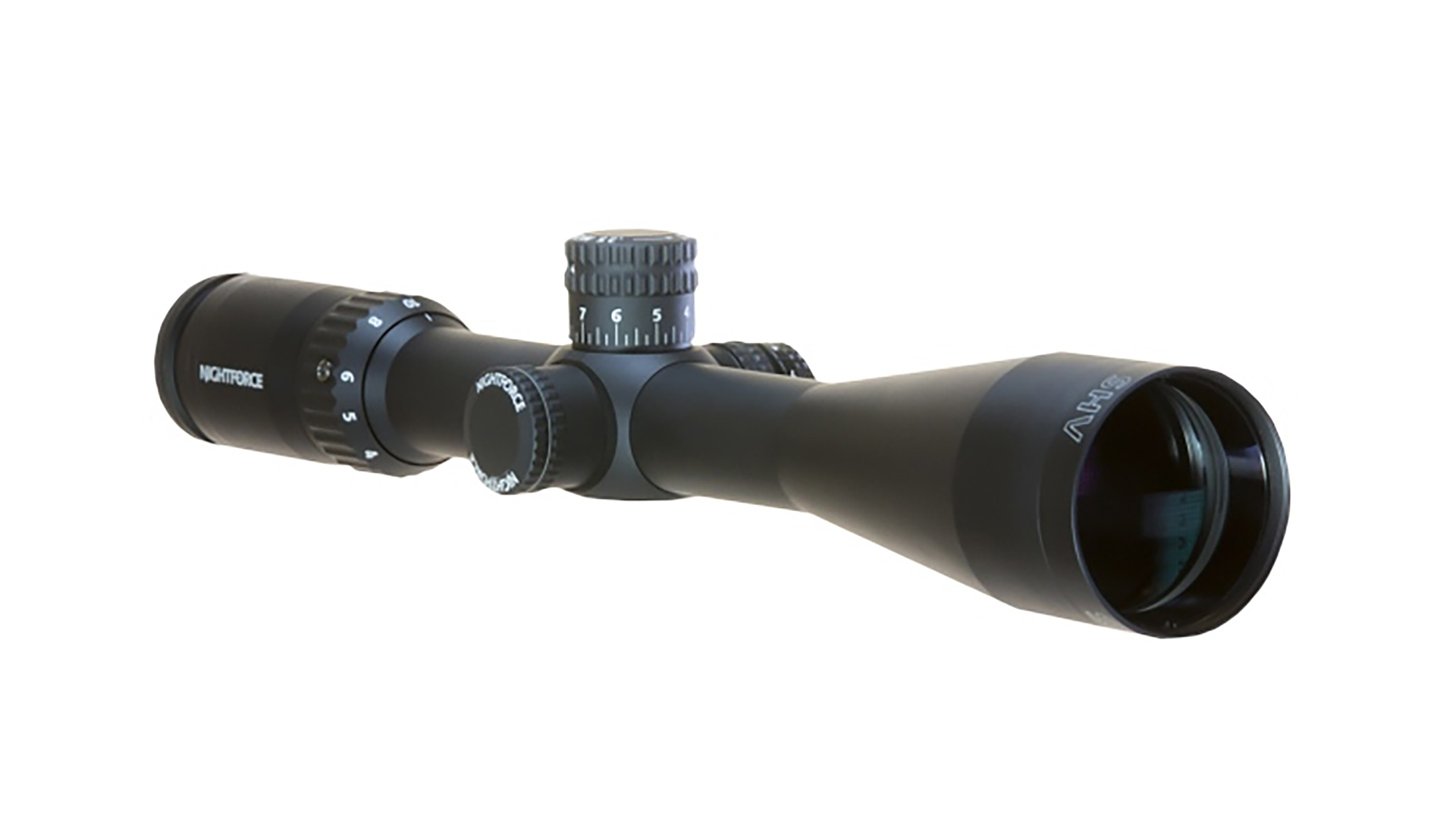Review: Nightforce SHV 4-14x50mm F1 Rifle Scope

Nightforce is known for its well-built, top-shelf precision rifle scopes, but the company also offers the SHV (Shooting, Hunting, Varminter) series, which are more affordable models best described as “everyday” versions of the company’s rugged second-focal-plane NXS tactical scopes. The NXS line helped make Nightforce a household name in tactical optics, and it’s not that SHV riflescopes are of lesser quality, it’s just that their construction is simpler to keep costs lower. Likewise, SHV scopes are designed for general-purpose shooting roles like hunting or varmint-shooting, as their name suggests. Most SHV scopes are second-focal-plane only, but for nearly a decade, Nightforce has sold first-focal-plane SHV models as well. At the tail end of 2023, Nightforce escalated the SHV line up a notch after releasing its most feature-rich, first-focal-plane SHV variant to date: the MRAD-based SHV 4-14x50mm F1 C694 scope. The new SHV 4-14x50mm F1 includes an exposed elevation turret and full parallax adjustment, but more importantly, it has the Nightforce Mil-XT reticle; a more sophisticated illuminated reticle with an integrated MRAD ballistic grid. With the Mil-XT and its other features, the C694 is a “true” precision-oriented Nightforce riflescope with entry level pricing.
Nightforce SHV 4-14x50mm F1 Overview
The Nightforce SHV 4-14x50mm F1 is a variable-magnification riflescope with an optical zoom factor of 3.5 and a magnification level that begins at 4X and tops out at 14X, making it suitable for “mid-range” shooting applications. Scopes in the SHV 4-14x50mm F1 family use a 6061 aluminum 30mm main tube that employs a wide 50mm objective lens to boost light-gathering abilities across all conditions. This scope and the rest of the SHVs are manufactured in Japan to keep costs affordable, but they still undergo a final inspection in Idaho by American workers. Like every other Nightforce scope, they include high-quality Japanese-made optical glass.
From the outset, the SHV 4-14x50mm F1 is laid out like the more expensive Nightforce scopes. It has a twisting ocular focus ring at the rear and a twisting ring to adjust magnification behind the turrets. The side-focus/parallax knob is conjoined to the 10-level illumination activation knob on the left side. Its windage and elevation turrets use .10-MRAD click values in conjunction with its 30mm diameter main tube. This scope also has 27-MRAD of total elevation adjustment and 19-MRAD of total windage adjustment.
The Nightforce Mil-XT Reticle
Nightforce’s addition of the illuminated MRAD Mil-XT reticle is the most notable aspect about this riflescope and what sets it apart from the previous SHV first focal plane models. With the Mil-XT, a shooter can dial or holdover a target with more ease, making this reticle useful for precision-rifle competitions, field/tactical use and extreme long-range shooting. Two main horizontal and vertical stadia lines in the center of the Mil-XT converge to create a small space with a useful central aiming point that measures a very fine .05-MRAD. Otherwise, both lines are divided into 1-MRAD segments and additional .2-MRAD hash marks. An MRAD-based grid that’s reminiscent of the grid on the classic Horus H59 reticle sits directly underneath the horizontal stadia line. This Mil-XT-specific grid is also divided by 1, .5 and .2-MRAD segments to facilitate everything from wind calls and ballistic compensation. The Mil-XT also has additional horizontal stadia lines that intersect the main vertical line at 1-MRAD intervals. I appreciated the easy-to-see numbers at either side of each horizontal row, since they add to this reticle’s ease of use. Only the principal stadia lines are illuminated. As far as fully featured modern precision reticles are concerned, the Mil-XT checks all of those boxes, and Nightforce offers it on its more expensive models as well.
Turrets
The SHV 4-14x50mm F1 C694 is currently one of two Nightforce SHV scopes with exposed turrets for easy dialing, and this turret also has an uncomplicated method to set the zero. Nightforce calls it “ZeroSet,” and all it requires the shooter to do is unscrew two small 5/64 Allen screws and lift the turret cap and place it on the “0” marking before tightening the screws again. As this is a “simpler” scope, the windage knob has no locking features of any kind, but it does come capped. The markings on both turrets are easily visible.
Practical Experiences
I mounted the Nightforce SHV 4-14x50mm F1 on Taurus’ new .308 Win. Expedition bolt-action rifle using a 20-MOA Nightforce Xtreme-Duty 1-piece Remington-700 short-action steel base and Nightforce Xtreme-Duty Ultralite 30mm medium-height scope-rings. After grouping a few cartridges of various types to get a feel for the rifle, I settled on the Federal 168-grain Gold Medal Match cartridge and zeroed the scope at 100 yards. Not counting the sighters, three different three-shot groups with Federal Gold Medal Match ammunition averaged out to .65 MOA. At this point I also “set” the ZeroSet to read “0.” With confidence in my zero and these cartridges, I executed a “Tall-Target Test” to measure the SHV 4-14x50mm F1’s turret tracking fidelity. In my test, I dialed up 10 MRAD and shot a careful three-round group. After letting the barrel cool, I dialed down to 5 MRAD and shot another group. Skipping over the maths and formulae, my correction factors for 10 and 5 MRAD respectively were 1.005 and 1.002. In plain English, this means that the turrets had approximately 1 percent error in tracking which, according to noted ballistician Bryan Litz, is perfectly acceptable for a precision scope in the real world.
I had no issue with the scope after adjusting its ocular focus and parallax settings. Seeing how I was able to print a handful of sub-MOA three-shot groups at 100 yards, the 100-yard setting on the parallax knob is accurate, and I was very satisfied with the Japanese glass used to build this scope. When shooting my tall-target test at 100 yards, I shot at cardboard against a white backdrop and noticed a small amount of chromatic aberration, just a tiny amount of purple fringing that isn’t uncommon with most scopes. Overall, I observed no major deficiencies with the glass; edge to edge clarity was also fine as was performance in overcast or dimmer conditions. While the ZeroSet feature isn’t as sophisticated as Nightforce’s ZeroStop found on more expensive models, it seems to work fine. However, with the cap adjusted to “0”, I could still dial four extra clicks “down,” so one would need to double-check when returning the turret to true zero.
The Takeaway

With its illuminated, full featured MRAD-based Mil-XT reticle, exposed elevation turrets and first focal plane capabilities, the Nightforce SHV 4-14x50mm F1 (C694) is also arguably the crown jewel of the SHV product line. In keeping its more affordable price-point, it’s expected that the SHV 4-14x50mm F1’s features wouldn’t be as elaborate. It has a more basic zero-locking system, a smaller 30mm diameter main tube, analog illumination, a simpler windage turret and it wasn’t built to withstand the abuse that some of the more expensive Nightforce scopes can take. However, at its price point around the $1,300 retail mark, a shooter can purchase this scope with its premium feature set, mount it on their rifle and generally run with the more expensive Nightforce NX8 and ATACR models–or even its original older NXS brothers.
Nightforce SHV 4-14x50mm F1 (C694) Specifications:
- Magnification Range: 4–14X
- Focal Plane: First-focal plane
- Main Tube Diameter: 30mm
- Overall Length: 14.8 inches
- Mounting Length: 6.1 inches
- Weight: 30 ounces
- Click Value: .10 MRAD
- Elevation Adjustment: 27 MRAD
- Windage Adjustment: 19 MRAD
- Parallax Adjustment: 25 yards to infinity
- Eye Relief: 3.1 inches
- Field-of-view at 100 yards/100 meters: 4X (25.1 feet, 8.4 meters), 14X (7.4 feet, 2.5 meters)
- Exit Pupil: 4X (10.8 mm), 14D (3.3mm)
- Illumination: Analog
- Battery: CR2032
- Zero-Locking System: Nightforce ZeroSet
- Accessories: Instruction manual, rubber bikini lens covers







